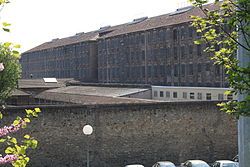Second largest prison in France
Fresnes Prison (French Centre pénitentiaire de Fresnes) is the second largest prison in France, located in the town of Fresnes, Val-de-Marne, south of Paris. It comprises a large men's prison (maison d'arrêt) of about 1200 cells, a smaller one for women and a penitentiary hospital.
Fresnes is one of the three main prisons of the Paris area, Fleury-Mérogis (Europe's largest prison) and La Santé (located in Paris) being the other two.
History
The prison was constructed between 1895 and 1898 according to a design devised by architect Henri Poussin. An example of the so-called "telephone-pole design," the facility was radically different from previous prisons. At Fresnes prison, for the first time, cell houses extended crosswise from a central corridor. The design was used extensively in
North America for much of the next century.[citation needed]
During World War II, Fresnes prison was used by the Germans to house captured British SOE agents and members of the French Resistance. Held in horrific conditions, many of these prisoners were tortured, and some died there.[1] As soon as the Allied forces broke through at Normandy and fought their way to liberate Paris, the Gestapo peremptorily killed prisoners at Fresnes. Fresnes Prison was liberated on 24 August 1944 by the French 2nd Armoured Division under General Philippe Leclerc, after a day of heavy fighting with many casualties on both sides.[2]
Modern day
Fresnes Prison has recently experienced many rebellions and arson incidents.[21][22]

